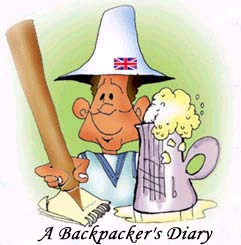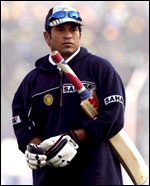 February 15, 2002
February 15, 2002
Incomparable India
- Jonathan Dyson
The day after the final one-day international in Mumbai, I left India to continue my travels to Australia. And just as flying from England to India was a culture shock, three months on, the same experience occurred in reverse, as I settled back down into the Western world.
Unfortunately, Kings Cross, the area where most of Sydney's backpacker's accommodation is to be found, is also one of the least pleasant areas of the city. On my first day, a local drugs-pusher grabbed a large amount of cash from my hand just after I had collected the money from an ATM. After chasing him down an empty street for a while, he turned round and threatened to punch me, so I came to my senses, said goodbye to the cash and went to the nearest police station.
It certainly came as a shock after three wonderful months in India, where I experienced very few difficulties of any kind, and found it be a thoroughly peaceful country. Violence is rare in India, and while there is plenty of noise on the streets, it generally comes from shop-owners and rickshaw drivers who are just desperate to sell you a banana or give you a ride.
By contrast, Kings Cross is bold, brash, and loud, and a good deal of the noise comes from the loquacious bouncers urging you to enter their strip club, well-tanned surfers returning from the beach, and the street-bound junkies looking for a hit. The area provides a parody of Australian culture at its most extreme.
However, thankfully, not all of Sydney is like this. In fact the area that directly surrounds the spectacular harbour, home to the famous Opera House and Harbour Bridge, is quite beautiful. And the botanic gardens nearby are home to all sorts of weird and wonderful trees, plants and birds.
It was here that I sat down to think about my Indian experience in a fresh light, now that I had, somewhat reluctantly, left for another cricket-mad country. Lonely Planet writes that while "most travellers leaving India are happy to find themselves on the flight home, most have a hankering to get back".
 For cricket fans it's different, and particularly for one as passionate as me. Each day spent at a cricket match in India leaves you wondering what will happen the following day. And the next day. And the next. The Indian side is so bewilderingly inconsistent, so addictively unpredictable, that you just can't look away. World-beaters one day, the world's worst the next, it's like a classic thriller, except without an ending.
For cricket fans it's different, and particularly for one as passionate as me. Each day spent at a cricket match in India leaves you wondering what will happen the following day. And the next day. And the next. The Indian side is so bewilderingly inconsistent, so addictively unpredictable, that you just can't look away. World-beaters one day, the world's worst the next, it's like a classic thriller, except without an ending.
And that's coming from an England fan who watched his side against India. Yet the same applies to the school, club and domestic cricket that I witnessed. Every time I wandered through a maidan, chatted to a group of cricket enthusiasts, or saw cricket being played in a street corner, something extraordinary and memorable would occur.
Young boys, playing a casual game in Calcutta, argue fiercely over whether the last delivery was a no-ball; grown men at each Test and one-dayer, jump up and down, waving their huge flag, desperate to get on the box; a schoolboy captain, wearing a furious look, gives his team the admonishment of its life.
It's been three months that have in turn thrilled, fascinated, enlightened, and charmed. Highlights? To name a few: partaking in a yoga session with Bedi and the boys in Delhi; seeing fourteen-year-old Sarvesh Damle compile a schoolboy century with the maturity of a Test player; meeting Ramakant Achrekar, the humble yet masterful tutor of Tendulkar; seeing Sachin himself score a century from dreamland at Ahmedabad; being among 90,000 other cricket-crazy fans at Eden Gardens, and then finding an even more intense atmosphere in Madras.
What has surprised me? For starters, the wonderfully open-minded, studious attitude to the game displayed by state players; the fiercely-contested club cricket, particularly in Madras; the deep knowledge and admiration for teams other than the beloved Ind-ee-ya; the unique format of Mumbai schools cricket; the variety of places, from riverbanks to railway tracks, where cricket is played; and most of all the astonishingly early time of day when cricket hits the streets, beaches and maidans - trust me: six or even seven am just doesn't exist in England.
Before I arrived in India, I had possessed for a long time the ambition of watching a Test match here. Now I want to see one as a neutral, to enjoy the crowd as it is, rather than, fun though it is, constantly mimicking it along with the other Barmies. I want to watch Sachin and Harbahjan simply as the immense talents they really are, without praying they are either dismissed for a duck, or hit out of the ground.
And here's another thing: for too long England have copied the Australian way, their academy, their day-night pyjama cricket, and even last summer the smaller things like parading the ball when a bowler reaches a five-wicket haul.
On my return to England in May, I'll write to the ECB to see if they are aware of the Indian way - state players who turn up for games with the enthusiasm of a twelve-year-old; school matches that ebb and flow like a Test; a club structure that allows a gradual move up the cricketing ladder. English cricket could do with just a few of these.
Well, I'm off now - after Oz, it's NZ for the Tests, then LA, then Canada. Then back to Blighty for the cricket season. Thanks for your mails, for all your thoughts, encouragement and help. I've left for now, but I know, one day, I'll be back.
GE Features
©1996 to 2001 rediff.com India Limited. All Rights Reserved.